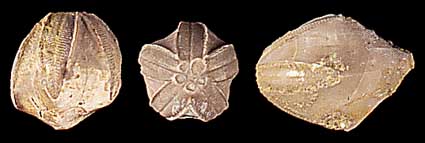Introduction to the Blastoidea


The Blastoidea is an extinct taxon of echinoderms. Originating in the Ordovician along with many other echinoderm classes, they reached their greatest diversity in the Mississippian, or early Carboniferous, and persisted until the end of Permian. Although never as diverse as their contemporaries the crinoids, blastoids are common fossils, especially in many Mississippian-age rocks. Like crinoids, blastoids were high-level stalked suspension feeders, filtering food particles out of the water column.
The fossils depicted on this page are specimens of what is probably the most common blastoid, Pentremites, from Mississippian rocks of Iowa. Like most echinoderms, blastoids were protected by a set of interlocking plates of calcium carbonate, forming the theca. Blastoids show a very regular and tightly integrated plate arrangement, which is in part responsible for their abundance as fossils: the theca held together after tha animal died. The theca of Pentremites has a rather nut-like shape, and fossil Pentremites are sometimes inaccurately called "fossil nuts" or "fossil hickory nuts". Other blastoid thecae ranged from conical to cylindrical to globular, and some had odd "fins" extending outwards.
In life, the theca of a typical blastoid was attached to a stalk, or column, made up of stacked disc-shaped plates. The other end of the column attached to the ocean floor -- very much like stalked crinoids. The mouth was located at the tip of the theca. Radiating from the center like flower petals were five food grooves, or ambulacra. In life, each ambulacrum had many long, thin, fine structures called brachioles, which were used to trap food particles and bring them to the mouth. Brachioles were delicate structures, and usually they are not preserved in place. The five holes that you can see on the specimen at the top of the picture, surrounding the star-shaped mouth, are the anus (the largest hole of the five) and the entrances to a set of five complex folded respiratory organs known as the hydrospires.


